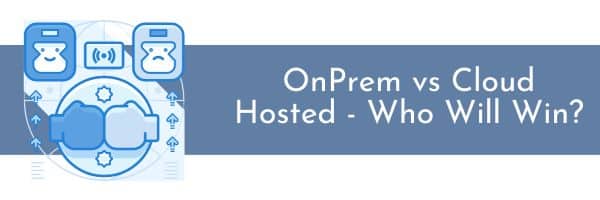With the rapid growth of digital transformation, businesses are faced with a crucial decision: to maintain their IT infrastructure on-premises or move to the cloud. Each option has its advantages and challenges, and the best choice often depends on a company’s specific needs, budget, and long-term goals. Here’s an objective way you can compare your legacy on-premises servers with cloud hosted. So, On-Prem Servers vs Cloud Hosted – who will win?
Here’s an objective (and infographic) look at the differences:
1. Cost Implications
On-Premises:
- Capital Expenditure (CapEx): Requires a large initial investment in hardware, software licenses, and infrastructure.
- Ongoing Costs: Ongoing patching and maintenance, warranties, upgrades, energy bills, and scheduled outages.
- Predictability: Fixed costs can be more predictable but can also lead to overprovisioning.
Cloud Computing:
- Operational Expenditure (OpEx): Pay-as-you-go model based on actual usage.
- Scalability: Can scale up or down based on needs, often leading to cost savings.
- No Hardware Costs: No need to purchase or maintain physical servers.
2. Scalability and Flexibility
On-Premises:
- Limited Scalability: Requires manual effort and investment to scale.
- Infrastructure Limitations: Dependent on physical space and hardware availability.
Cloud Computing:
- Instant Scalability: Resources can be added or reduced instantly.
- Global Reach: Can deploy services in multiple regions worldwide.
3. Security and Compliance
On-Premises:
- Physical Security: Businesses have full control over physical access to servers.
- Customization: Can tailor security protocols to specific needs.
Cloud Computing:
- Advanced Security Features: Providers invest in top-tier security measures, including encryption, firewalls, and multi-factor authentication.
- Compliance: Many providers offer compliance certifications for various regulations.
4. Maintenance and Updates
On-Premises:
- Manual Updates: Requires IT staff to manually update and patch software.
- Downtime Risks: Potential for longer downtimes during updates.
Cloud Computing:
- Automatic Updates: Providers handle software updates, often with minimal disruption.
- Continuous Monitoring: Constant monitoring for potential issues and threats.
5. Accessibility and Collaboration
On-Premises:
- Network Limitations: Access typically limited to the company’s internal network.
- VPN Dependency: Remote access often requires VPNs, which can be slower.
Cloud Computing:
- Anywhere Access: Can access resources from any location with an internet connection.
- Collaboration Tools: Many cloud platforms offer tools for real-time collaboration.
Conclusion:
On-Prem Servers vs Cloud Hosted – who will win? Both on-premises and cloud computing offer distinct advantages. Make sure to evaluate your specific needs, growth projections, and budget constraints to make an informed decision!





